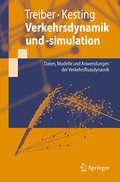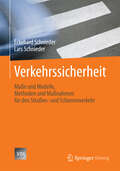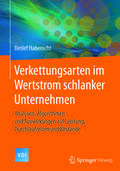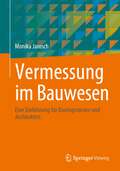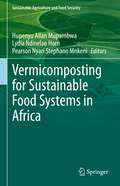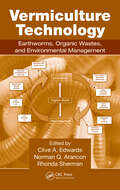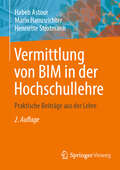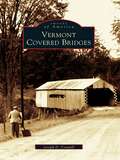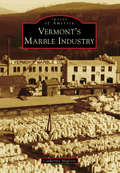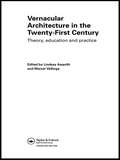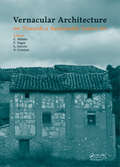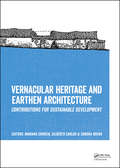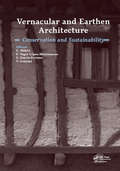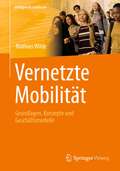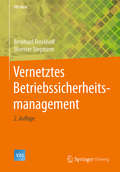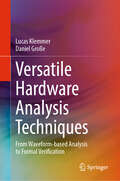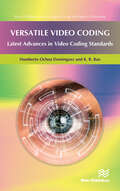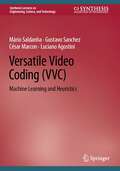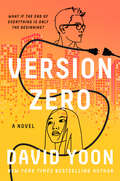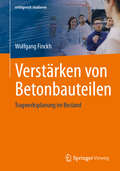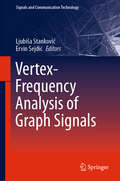- Table View
- List View
Verkehrsdynamik und -simulation
by Martin Treiber Arne KestingDas Lehrbuch liefert eine umfassende Darstellung der Modellierung und Dynamik des Straßenverkehrs. Es erschließt Studierenden ein Gebiet, das bisher nur in der englischsprachigen Originalliteratur dargestellt wurde. Aktuelle Anwendungen in Bereichen wie Verkehrsmanagement, Fahrer-Assistenzsysteme oder Verkehrstelematik stellen den Praxisbezug her, zahlreiche Abbildungen und Übungsaufgaben vertiefen das Verständnis. Das Buch richtet sich an Physik- und Verkehrsingenieurstudenten sowie Studierende der Informatik, Mathematik und technischer Richtungen.
Verkehrsplanung für Einzelhandelsstandorte: Ein Praxisleitfaden
by Siegmar Gumz Claudia Nash Matthias JakobFür eine erfolgreiche Durchführung von Einzelhandelsprojekten stellen die gute Erreichbarkeit sowie die verkehrliche Verträglichkeit zentrale Voraussetzungen dar. Eine umfassende Untersuchung dieser Anforderungen im Rahmen fundierter Verkehrsgutachten entscheidet somit darüber, ob ein Verkehrskonzept dauerhaft tragfähig und wirtschaftlich ist. Dieses Buch liefert einen praxisorientierten und umfassenden Überblick über die einzelnen Arbeitsschritte bei der verkehrlichen Erschließung von Einzelhandelsstandorten. Hierbei wird u.a. für die einzelnen Planungsphasen auf entsprechende zentrale Richtlinien sowie auf Erfahrungen aus der Planungspraxis verwiesen. Es handelt sich um ein übersichtliches Nachschlagewerk für Stadt- und Verkehrsplaner, Architekten sowie alle Akteure, die in die Standortsuche sowie die verkehrliche Erschließung von Einzelhandelsvorhaben eingebunden sind.
Verkehrsplanung, Bau und Betrieb von Verkehrsanlagen: Technik – Organisation – Wirtschaftlichkeit (Handbuch für Bauingenieure)
by Carsten GertzDer vorliegende Band aus der Reihe Handbuch für Bauingenieure erläutert wichtige grundlegende und aktuelle Inhalte der Fachgebiete Verkehrsplanung, Bau und Betrieb von Verkehrsanlagen.Die Mobilität von Personen und der Transport von Gütern haben für unseren Alltag und die ökonomische Entwicklung eine zentrale Bedeutung. Der Verkehrssektor ist dabei weiterhin von einer großen Dynamik geprägt. Sowohl die Erweiterung, Bestandserhaltung und qualitative Verbesserung der Verkehrsnetze und Knotenpunkte erfordern hohe Investitionen.Aufgaben wie Klimaanpassung oder die Neuaufteilung von Verkehrsflächen in urbanen Räumen kommen dazu. Die Anpassung an neue Technologien und Angebotsformen sind weitere Herausforderungen. Die Zeit der traditionellen Angebotsplanung an einen steigenden Bedarf ist lange vorbei. Die zeitliche, räumliche oder modale Steuerung der Verkehrsnachfrage ist für die Erreichung von Umwelt- und Qualitätszielen von zentraler Bedeutung geworden. Damit geht es nicht mehr nur um die effiziente und umweltverträgliche Errichtung von Verkehrsinfrastruktur, sondern auch um das umfassende Management der betrieblichen Prozesse.Dieser Band ist Teil der Reihe Handbuch für Bauingenieure, die insgesamt sieben Bände umfasst. Dazu gehören Allgemeine Grundlagen des Bauingenieurwesens; Bauwirtschaft und Baubetrieb; Konstruktiver Ingenieurbau und Hochbau; Geotechnik; Wasserbau, Siedlungswasserwirtschaft, Abfalltechnik; Raumplanung, Stadtentwicklung und Öffentliches Baurecht; Verkehrsplanung sowie Bau und Betrieb von Verkehrsanlagen.
Verkehrssicherheit
by Eckehard Schnieder Lars SchniederDer Band liefert erstmals eine methodische Darstellung zur Verkehrssicherheit in einem begriffs- und systemtheoretischen Ansatz, der sozial- wie technikwissenschaftliche Perspektiven integriert. Vorgestellt werden Methoden für die Erforschung und Gestaltung von Verkehrssystemen hinsichtlich der Verkehrssicherheit. Ausgehend von der begrifflichen Analyse stellt der Band Ansätze zur Definition von Verkehrssicherheit vor, erklärt anhand dieser Modelle die historische Entwicklung und leitet Prognosen für die weitere Entwicklung der Verkehrssicherung ab.
Verkettungsarten im Wertstrom schlanker Unternehmen: Analysen, Algorithmen und Auswirkungen auf Leistung, Durchlaufzeiten und Bestände (VDI-Buch)
by Detlef HabenichtIn dem Werk werden im Bottom-Up-Verfahren die Verkettungsarten von der Starren, Hand-Shake und Stauf#65533;higen, #65533;ber die Lose bis hin zur Hierarchischen Verkettung strukturiert aufbereitet, die Arbeitsweisen diskutiert und die grundlegenden Abh#65533;ngigkeiten durch Algorithmen definiert, um daraus die Optimierungsans#65533;tze auch im Sinne von Leistung, Durchlaufzeit und Best#65533;nden zu entwickeln. Der Autor setzt nicht auf die #65533;blichen Verfahren der Top-Down-Philosophien wie Industrie4. 0, CIM, Lean Production, sondern auf die Back-To-The-Roots-Philosophie des gesunden Menschenverstands; also zur#65533;ck zur bew#65533;hrten Ingenieurarbeit, bei der alle Problemstellen bis zur vollen Kenntnis analysiert und dann die L#65533;sung mit verifizierbarem Ziel implementiert wird. Unternehmen k#65533;nnen sich nur verschlanken, wenn die Prozesse dieses im Detail zulassen.
Vermessung im Bauwesen: Eine Einführung für Bauingenieure und Architekten
by Monika JaroschDie Lektüre soll den Einstieg des fachfremden Neulings in die Welt der Vermessung von heute ermöglichen. Ein Grundverständnis für die physikalischen und geometrischen Zusammenhänge wird hergestellt. Im Rahmen der Vermessung werden Raumdaten erzeugt. Ziel ist es, den geeigneten Einsatz der etablierten Instrumente und Verfahren sicherzustellen. Die Auswertung erzielter Messergebnisse und die Beurteilung deren Qualität sind auf das notwendige Maß reduziert und werden anhand von Beispielen nachvollziehbar vermittelt. Mit minimalem Aufwand soll ein umfassendes Verständnis eines Bauingenieurs oder Architekten für den Einsatz moderner Messautomaten entwickelt werden. Die zweckorientierte Auswahl des besten Verfahrens ebenso wie die Möglichkeiten moderner Instrumente stehen im Vordergrund.
Vermicomposting for Sustainable Food Systems in Africa (Sustainability Sciences in Asia and Africa)
by Hupenyu Allan Mupambwa Lydia Ndinelao Horn Pearson Nyari Stephano MnkeniThis edited book collates the research done mainly in Africa on vermicomposting and related technologies that can assist African smallholder farmers in making nutrient rich organic fertilizers from their animal and crop residue wastes. Information on the development of organic sources of liquid fertilizer development for hydroponics is also presented. The book presents research findings on vermicomposting in a simplified way that will allow farmers and extension workers to adopt the indicated technologies. The book also covers critical aspects of standardization of vermicompost preparation, earthworm biology, nutrient enrichment of composts and organic liquid fertilizer production.Vermicomposting is a technology that employs earthworms to enhance the biodegradation and fertilizer value of organic wastes. The earthworms optimize the biodegradation ecosystem during composting, resulting in a final nutrient rich product with more recalcitrant forms of carbon and much lower levels of veterinary antibiotics and their metabolites. Vermicompost as an organic fertilizer is highly preferred over other forms of soil enhancers. A lot of research has been done on vermicompost and related activities in Africa but remain scattered across various publications.The book is an invaluable source of information for farmers especially those practicing organic crop production, vermicomposting researchers, as well as extension workers.
Vermiculture Technology: Earthworms, Organic Wastes, and Environmental Management
by Rhonda Sherman Clive A. Edwards Norman Q. AranconCo-edited by international earthworm expert Clive A. Edwards, Vermiculture Technology: Earthworms, Organic Wastes, and Environmental Management is the first international, comprehensive, and definitive work on how earthworms and microorganisms interact to break down organic wastes on a commercial basis. Many books cover the importance of composting
Vermittlung von BIM in der Hochschullehre: Positionspapier des Arbeitskreises BIM im Baubetrieb des Fachausschusses Baubetrieb und Bauwirtschaft (essentials)
by Henriette Strotmann Habeb Astour Mario HanusrichterIn Bezug auf das Bauwesen lässt sich Building Information Modeling (BIM) als ein wichtiger Impulsgeber für den stattfindenden Digitalisierungsprozess benennen. Studierende der baurelevanten Fachdisziplinen müssen daher auf den sicheren Umgang mit dieser Methode vorbereitet werden.Das vorliegende Positionspapier definiert die wichtigsten Lehrinhalte zur Vermittlung von Kenntnissen, Fertigkeiten und Kompetenzen im Bereich BIM, die an den deutschen Fachhochschulen in den Baustudiengängen Berücksichtigung finden sollten. Neben den allgemeinen BIM-Lehrinhalten behandelt das Positionspapier insbesondere die Anforderungen an BIM im Fachgebiet Baubetrieb.
Vermittlung von BIM in der Hochschullehre: Praktische Beiträge aus der Lehre (Essentials Ser.)
by Henriette Strotmann Habeb Astour Mario HanusrichterFür das Bauwesen ist Building Information Modeling (BIM) ein wichtiger Impulsgeber für den stattfindenden Digitalisierungsprozess. Studierende der baurelevanten Fachdisziplinen müssen daher auf den sicheren Umgang mit dieser Methode vorbereitet werden. Das vorliegende Buch definiert die wichtigsten Lehrinhalte zur Vermittlung von Kenntnissen, Fertigkeiten und Kompetenzen zu BIM, die an deutschen HAWs in Baustudiengängen Berücksichtigung finden sollten. Neben den allgemeinen BIM-Lehrinhalten behandelt das Buch insbesondere die Umsetzung von BIM mit Beispielen aus verschiedenen Hochschulen.
Vermont Covered Bridges
by Joseph D. ConwillWhen we think of covered bridges, we think of Vermont. Today, the state still boasts a hundred covered bridges, and records tell of hundreds more such historical structures no longer in existence. Vermont Covered Bridges offers views of the most interesting and beautiful of these bygone covered bridges, as well as old photographs of existing structures. The images are drawn from the archives of the National Society for the Preservation of Covered Bridges (NSPCB), including the incomparable Richard Sanders Allen Collection and the work of noted photographers Henry A. Gibson, Raymond Brainerd, and others. Royalties from the sales of this book will benefit the NSPCB.
Vermont's Marble Industry
by Catherine MiglorieThe marble deposits in Vermont are some of the richest in the world. Vermont's Marble Industry takes readers deep inside the quarries of the Green Mountain State to show how stone was sawed and raised from the earth to be cut, polished, and carved into monuments and structures that today are spread across the country. During the late 1800s, the marble industry flourished and the mighty Vermont Marble Company was started by a local family. The patriarch of the Proctor family built the Vermont Marble Company into the largest stone company in the world. They hired immigrant workers to fuel the company, and the region became a melting pot of nationalities. After World War II, demand for blocks of heavy dimension stone diminished and the slow demise of the Vermont Marble Company began. Vermont's Marble Industry proudly tells the history of the marble workers, their skilled craftsmanship, and the communities that relied on this industry.
Vernacular Architecture in the 21st Century: Theory, Education and Practice
by Marcel Vellinga Lindsay AsquithThe issues surrounding the function and meaning of vernacular architecture in the twenty-first century are complex and extensive. Taking a distinctively rigorous theoretical approach, this book considers these issues from a number of perspectives, broadening current debate to a wider multidisciplinary audience. These collected essays from the leading experts in the field focus on theory, education and practice in this essential sector of architecture, and help to formulate solutions to the environmental, disaster management and housing challenges facing the global community today.
Vernacular Architecture: Towards a Sustainable Future
by C. Mileto V. Cristini F. Vegas L. García SorianoSustainability is a concept that has monopolised a large number of the scientific debates in a wide range of spheres connected not only with architecture, urban planning and construction, but also with the product market, tourism, culture, etc. However, sustainability is indissolubly linked to vernacular architecture and the lessons this architectu
Vernacular Heritage and Earthen Architecture
by Mariana Correia Gilberto Carlos Sandra RochaIn a continuously changing world, there has been a growing interest in the protection of vernacular heritage and earthen architecture. The need to protect and enhance this fragile heritage via intelligent responses to threats from nature and the environment has become evident.Historically, vernacular heritage research focussed on philosophical aspe
Vernacular and Earthen Architecture: Proceedings of SosTierra 2017 (Valencia, Spain, 14-16 September 2017)
by Camilla Mileto Fernando Vegas López-Manzanares Lidia García-Soriano Valentina CristiniVernacular architecture in general and earthen architecture in particular, with their rich variety of forms worldwide, are custodians of the material culture and identity of the peoples who built them. In addition, they are widely recognized as ancestral examples of sustainability in all their variants and interpretations, and the architecture of the present ought to learn from these when designing the sustainable architecture of the future. The conservation of these architectures – seemingly simple yet full of wisdom – is to be undertaken now given their intrinsic value and their status as genuine examples of sustainability to be learnt from and interpreted in contemporary architecture. Vernacular and earthen architecture: Conservation and Sustainability will be a valuable source of information for academics and professionals in the fields of Environmental Science, Civil Engineering, Construction and Building Engineering and Architecture.
Vernetzte Mobilität: Grundlagen, Konzepte und Geschäftsmodelle (erfolgreich studieren)
by Mathias WildeDas Lehrbuch gibt eine Einführung in die Konzepte vernetzter Mobilität und geht dabei insbesondere auf deren Grundlagen, Organisationsformen und Geschäftsmodelle ein. Schwerpunkte liegen auf den Connected Car Services der Automobilindustrie, neueren Mobilitätsdienstleistungen und Angebote der Plattformökonomie. Damit richtet sich das Lehrbuch in erster Linie an Bachelor- und Masterstudierende in den Studiengängen des Automobilbaus und -managements, den Wirtschaftswissenschaften, der Verkehrsplanung, Stadt- und Regionalentwicklung oder Geographie.
Vernetztes Betriebssicherheitsmanagement (VDI-Buch)
by Bernhard Tenckhoff Silvester SiegmannSicherheitsmanagement im Betrieb ist für Sicherheitsbeauftragte und andere verantwortliche Fachkräfte eine komplexe Herausforderung. Das Standardwerk beschreibt auf über 500 Seiten die wichtigsten Grundlagen für ein vernetztes Sicherheitsmanagement: Wie lassen sich die Teildisziplinen Risikomanagement, Sicherheits- und Gesundheitsschutzmanagement, Umweltschutzmanagement, Datenschutzmanagement und Krisenmanagement möglichst effizient integrieren? Der in dem Buch beschriebene Ansatz bildet einen Bezugsrahmen für das Verhalten der Mitarbeiter und maximiert die Lebensfähigkeit des Unternehmens. Somit sind ganzheitlich verstandene Betriebssicherheit, Compliance und Risikomanagement ein nicht zu unterschätzender Wirtschaftsfaktor. Übersichtlich, praxisorientiert und gut lesbar stellen die Autoren die Möglichkeiten eines vernetzten Betriebssicherheitsmanagementkonzeptes vor. Das Ziel ist, ein möglichst optimal strukturiertes Vorgehen und ein vernetztes Wirken. Dazu gehören die Definition und Beherrschung der betrieblichen Risiken genauso wie die Schaffung einer präventiven Unternehmenskultur und die Sicherstellung der Compliance für Vorstände und Führungskräfte. Auch die neue VDI-Richtlinie 4055 „Betriebssicherheitsmanagement“ wird in dem Band erläutert. Das Buch richtet sich an Fachkräfte und Experten für Betriebssicherheit und eignet sich als Lehrbuch für Weiterbildungen und Studiengänge im Bereich Betriebssicherheitsmanagement und Sicherheitstechnik. Der Anhang enthält Checklisten und weiteres Material, das Fachkräfte bei der Umsetzung eines integrierten Sicherheitsmanagements unterstützt.
Versatile Hardware Analysis Techniques: From Waveform-based Analysis to Formal Verification
by Daniel Große Lucas KlemmerThis book describes several versatile hardware analysis techniques that tackle existing and new challenges. These techniques cover different phases of the hardware development process, including the verification, debugging, and post-synthesis optimization phases. The authors introduce the Waveform Analysis Language (WAL), which allows users to code analysis tasks in the form of programs that run on waveforms. The book covers processor verification, formal microcode verification, programmable automated waveform analysis demonstrated for a large variety of previously manual analysis tasks, as well as netlist optimization leveraging formal methods. All methods are available as open source, typically include examples on RISC-V analysis problems, providing a strong foundation for the community.
Versatile Video Coding
by K.R. Rao Humberto Ochoa DominguezVideo is the main driver of bandwidth use, accounting for over 80 per cent of consumer Internet traffic. Video compression is a critical component of many of the available multimedia applications, it is necessary for storage or transmission of digital video over today's band-limited networks. The majority of this video is coded using international standards developed in collaboration with ITU-T Study Group and MPEG. The MPEG family of video coding standards begun on the early 1990s with MPEG-1, developed for video and audio storage on CD-ROMs, with support for progressive video. MPEG-2 was standardized in 1995 for applications of video on DVD, standard and high definition television, with support for interlaced and progressive video. MPEG-4 part 2, also known as MPEG-2 video, was standardized in 1999 for applications of low- bit rate multimedia on mobile platforms and the Internet, with the support of object-based or content based coding by modeling the scene as background and foreground. Since MPEG-1, the main video coding standards were based on the so-called macroblocks. However, research groups continued the work beyond the traditional video coding architectures and found that macroblocks could limit the performance of the compression when using high-resolution video. Therefore, in 2013 the high efficiency video coding (HEVC) also known and H.265, was released, with a structure similar to H.264/AVC but using coding units with more flexible partitions than the traditional macroblocks. HEVC has greater flexibility in prediction modes and transform block sizes, also it has a more sophisticated interpolation and de blocking filters. In 2006 the VC-1 was released. VC-1 is a video codec implemented by Microsoft and the Microsoft Windows Media Video (VMW) 9 and standardized by the Society of Motion Picture and Television Engineers (SMPTE). In 2017 the Joint Video Experts Team (JVET) released a call for proposals for a new video coding standard initially called Beyond the HEVC, Future Video Coding (FVC) or known as Versatile Video Coding (VVC). VVC is being built on top of HEVC for application on Standard Dynamic Range (SDR), High Dynamic Range (HDR) and 360° Video. The VVC is planned to be finalized by 2020. This book presents the new VVC, and updates on the HEVC. The book discusses the advances in lossless coding and covers the topic of screen content coding. Technical topics discussed include: Beyond the High Efficiency Video CodingHigh Efficiency Video Coding encoderScreen contentLossless and visually lossless coding algorithmsFast coding algorithmsVisual quality assessmentOther screen content coding algorithmsOverview of JPEG Series
Versatile Video Coding: Machine Learning and Heuristics (Synthesis Lectures on Engineering, Science, and Technology)
by Luciano Agostini Gustavo Sanchez César Marcon Mário SaldanhaThis book discusses the Versatile Video Coding (VVC), the ISO and ITU state-of-the-art video coding standard. VVC reaches a compression efficiency significantly higher than its predecessor standard (HEVC) and it has a high versatility for efficient use in a broad range of applications and different types of video content, including Ultra-High Definition (UHD), High-Dynamic Range (HDR), screen content, 360º videos, and resolution adaptivity. The authors introduce the novel VVC tools for block partitioning, intra-frame and inter-frames predictions, transforms, quantization, entropy coding, and in-loop filtering. The authors also present some solutions exploring VVC encoding behavior at different levels to accelerate the intra-frame prediction, applying statistical-based heuristics and machine learning (ML) techniques.
Verschleiß metallischer Werkstoffe
by Karl Sommer Rudolf Heinz Jörg SchöferDieses Fachbuch ist vor allem für die praktische Arbeit des Ingenieurs gedacht und zeigt den richtigen Umgang anhand zahlreicher Schadensbeispiele. Außerdem gibt es zuverlässige Hilfestellung bei der Analyse und Beurteilung von Verschleißproblemen. Weiterhin beschreibt es geeignete Maßnahmen für die Optimierung von Sicherheit und Zuverlässigkeit beim Betrieb von Anlagen und Maschinen. Die neue aktuelle Auflage enthält an jedem Hauptkapitelanfang Kurzzusammenfassungen zur schnellen Orientierung. Die Qualität einzelner Bilder wurde verbessert.
Version Zero
by David YoonFrom the brilliant mind of New York Times bestselling author David Yoon comes a lightning-fast and scorchingly observant thriller about how we can save ourselves from the very real perils of a virtual world.Max, a data whiz at the social media company Wren, has gotten a firsthand glimpse of the dark side of big tech. When he questions what his company does with the data they collect, he's fired...then black-balled across Silicon Valley. With time on his hands and revenge on his mind, Max and his longtime friend (and secretly the love of his life) Akiko, decide to get even by rebooting the internet. After all, in order to fix things, sometimes you have to break them. But when Max and Akiko join forces with a reclusive tech baron, they learn that breaking things can have unintended--and catastrophic--consequences.
Verstärken von Betonbauteilen: Tragwerksplanung im Bestand (erfolgreich studieren)
by Wolfgang FinckhDieses Lehrbuch widmet sich dem Bauen im Bestand mit Betonbauteilen und den dabei häufig vorkommenden Verstärkungsmaßnahmen. Dazu wird zunächst das Sicherheitskonzept bestehender Bauteile erläutert. Darauf aufbauend wird die Analyse der Bestandsmaterialien und das Vorgehen bei einer Analyse des Tragverhaltens des Bestandsbauteils bzw. einer Nachrechnung behandelt. Die weiteren Kapitel des Buches beschäftigen sich mit dem Verstärken der bestehenden Betonbauteile. Hierbei werden alle gängigen Verstärkungen im Stahlbetonbau, wie das Verstärken mit geklebter Bewehrung, Carbonbeton, Betonschrauben und das Verstärken mittels Auf- und Spritzbeton, erklärt. Dabei werden bei allen Verfahren die Gemeinsamkeiten, die Unterschiede sowie die sinnvollsten Anwendungsgebiete herausgearbeitet. Die theoretischen Grundlagen werden anhand zahlreicher Abbildungen verdeutlicht. In jedem Kapitel sind zum besseren Verständnis umfangreiche Bemessungsbeispiele mit Praxisbezug enthalten. Die erfolgreiche Lektüre dieses Buches ermöglicht dem Lesenden, sich den tragwerksplanerischen Aufgaben von bestehenden Betonbauwerken zu stellen und Verstärkungsmaßnahmen zu berechnen.
Vertex-Frequency Analysis of Graph Signals (Signals and Communication Technology)
by Ervin Sejdić Ljubiša StankovićThis book introduces new methods to analyze vertex-varying graph signals. In many real-world scenarios, the data sensing domain is not a regular grid, but a more complex network that consists of sensing points (vertices) and edges (relating the sensing points). Furthermore, sensing geometry or signal properties define the relation among sensed signal points. Even for the data sensed in the well-defined time or space domain, the introduction of new relationships among the sensing points may produce new insights in the analysis and result in more advanced data processing techniques. The data domain, in these cases and discussed in this book, is defined by a graph. Graphs exploit the fundamental relations among the data points. Processing of signals whose sensing domains are defined by graphs resulted in graph data processing as an emerging field in signal processing.Although signal processing techniques for the analysis of time-varying signals are well established, the corresponding graph signal processing equivalent approaches are still in their infancy. This book presents novel approaches to analyze vertex-varying graph signals. The vertex-frequency analysis methods use the Laplacian or adjacency matrix to establish connections between vertex and spectral (frequency) domain in order to analyze local signal behavior where edge connections are used for graph signal localization. The book applies combined concepts from time-frequency and wavelet analyses of classical signal processing to the analysis of graph signals. Covering analytical tools for vertex-varying applications, this book is of interest to researchers and practitioners in engineering, science, neuroscience, genome processing, just to name a few. It is also a valuable resource for postgraduate students and researchers looking to expand their knowledge of the vertex-frequency analysis theory and its applications. The book consists of 15 chapters contributed by 41 leading researches in the field.
